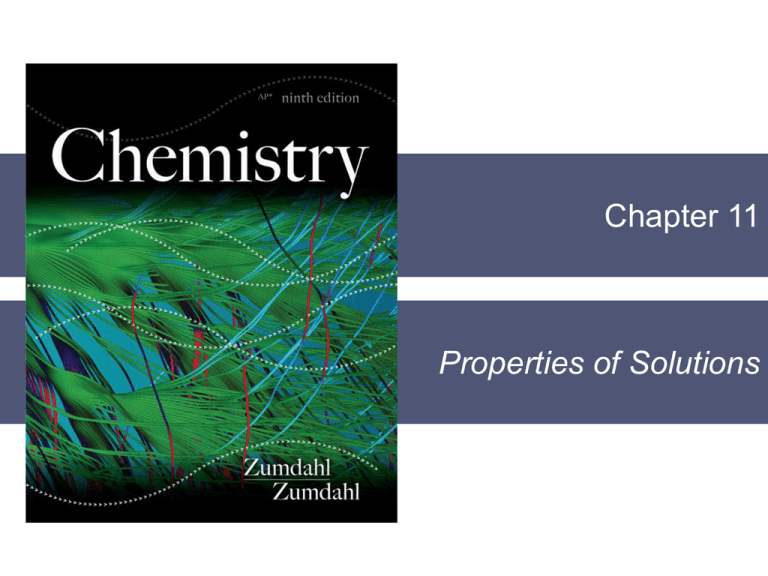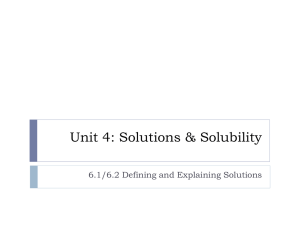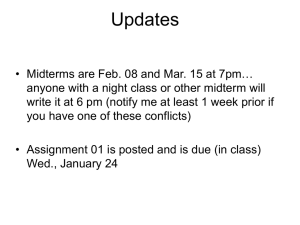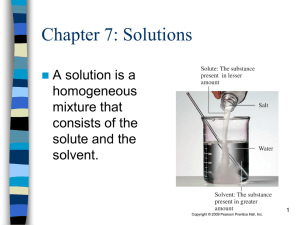
AP*
Chapter 11
Properties of Solutions
AP Learning Objectives
LO 1.16 The student can design and/or interpret the results of an experiment
regarding the absorption of light to determine the concentration of an
absorbing species in a solution. (Sec 11.1)
LO 2.8 The student can draw and/or interpret representations of solutions that
show the interactions between the solute and solvent. (Sec 11.1)
LO 2.9 The student is able to create or interpret representations that link the
concept of molarity with particle views of solutions. (Sec 11.2)
LO 2.14 The student is able to apply Coulomb’s Law qualitatively (including using
representations) to describe the interactions of ions, and the attractions
between ions and solvents to explain the factors that contribute to the solubility
of ionic compounds. (Sec 11.2)
LO 2.15 The student is able to explain observations regarding the solubility of
ionic solids and molecules in water and other solvents on the basis of particle
views that include intermolecular interactions and entropic effects. (Sec 11.211.3)
AP Learning Objectives
LO 5.10 The student can support the claim about whether a process is a
chemical or physical change (or may be classified as both) based on whether the
process involves changes in intramolecular versus intermolecular interactions.
(Sec 11.2)
LO 6.24 The student can analyze the enthalpic and entropic changes associated
with the dissolution of a salt, using particulate level interactions and
representations. (Sec 11.2)
Section 11.1
Solution Composition
AP Learning Objectives, Margin Notes and References
Learning Objectives
LO 1.16 The student can design and/or interpret the results of an experiment regarding the absorption of light to
determine the concentration of an absorbing species in a solution.
LO 2.8 The student can draw and/or interpret representations of solutions that show the interactions between the
solute and solvent.
AP Margin Notes
Spectral analysis is a common method for analyzing the composition of a solution. See Appendix 3 “Spectral
Analysis” for a discussion of the Beer-Lambert law.
Additional AP References
LO 1.16 (see APEC #2, “The Percentage of Copper in Brass”)
Section 11.1
Solution Composition
Solutions are homogeneous mixtures of two or more
pure substances.
In a solution, the solute is dispersed uniformly
throughout the solvent.
Section 11.1
Solution Composition
Various Types of Solutions
Copyright © Cengage Learning. All rights reserved
6
Section 11.1
Solution Composition
Solution Composition
moles of solute
Molarity (M ) =
liters of solution
mass of solute
Mass (weight) percent =
100%
mass of solution
moles A
Mole fraction ( A ) =
total moles of solution
Molality (m ) =
Copyright © Cengage Learning. All rights reserved
moles of solute
kilogram of solvent
7
Section 11.1
Solution Composition
Molarity (M) depends n the volume of solution, so it will
change slightly with temperature.
Molality (m) is independent of temperature because it
depends only on mass.
Copyright © Cengage Learning. All rights reserved
8
Section 11.1
Solution Composition
Copyright © Cengage Learning. All rights reserved
9
Section 11.1
Solution Composition
Normality (N) = number of equivalents
liters of solution
The definition of equivalent depends on the reaction
type.
Acid/ Base – the mass of acid or base that can furnish or
accept exactly 1 mole of protons
Redox – the quantity of oxidizing or reducing agent that
can furnish or accept exactly 1 mole of electrons
Copyright © Cengage Learning. All rights reserved
10
Section 11.1
Solution Composition
Copyright © Cengage Learning. All rights reserved
11
Section 11.2
The Energies of Solution Formation
AP Learning Objectives, Margin Notes and References
Learning Objectives
LO 2.9 The student is able to create or interpret representations that link the concept of molarity with particle
views of solutions.
LO 2.14 The student is able to apply Coulomb’s Law qualitatively (including using representations) to describe the
interactions of ions, and the attractions between ions and solvents to explain the factors that contribute to the
solubility of ionic compounds.
LO 2.15 The student is able to explain observations regarding the solubility of ionic solids and molecules in water
and other solvents on the basis of particle views that include intermolecular interactions and entropic effects.
LO 5.10 The student can support the claim about whether a process is a chemical or physical change (or may be
classified as both) based on whether the process involves changes in intramolecular versus intermolecular
interactions.
LO 6.24 The student can analyze the enthalpic and entropic changes associated with the dissolution of a salt, using
particulate level interactions and representations.
Additional AP References
LO 5.10 (see Appendix 7.6, “Distinguishing between Chemical and Physical Changes at the Molecular Level”)
LO 6.24 (see Appendix 7.7, “Intermolecular Forces and Thermodynamics: Why Aren’t All Ionic Solids Soluble in
Water?”)
Section 11.2
The Energies of Solution Formation
The ability of substances to form
solutions depends on
intermolecular forces
natural tendency toward mixing
Section 11.2
The Energies of Solution Formation
Intermolecular Forces of Attraction
Any intermolecular force of attraction
(Chapter 10) can be the attraction between
solute and solvent molecules.
Section 11.2
The Energies of Solution Formation
Formation of a Liquid Solution
1. Separating the solute into its individual components
(expanding the solute).
2. Overcoming intermolecular forces in the solvent to
make room for the solute (expanding the solvent).
3. Allowing the solute and solvent to interact to form the
solution.
Copyright © Cengage Learning. All rights reserved
15
Section 11.2
The Energies of Solution Formation
Steps in the Dissolving Process
Gas
Gas
Copyright © Cengage Learning. All rights reserved
16
Section 11.2
The Energies of Solution Formation
Steps in the Dissolving Process
Steps 1 and 2 require energy, since forces must be
overcome to expand the solute and solvent.
Step 3 usually releases energy.
Steps 1 and 2 are endothermic, and step 3 is often
exothermic.
Copyright © Cengage Learning. All rights reserved
17
Section 11.2
The Energies of Solution Formation
Enthalpy (Heat) of Solution
Enthalpy change associated with the formation of the
solution is the sum of the ΔH values for the steps:
ΔHsoln = ΔH1 + ΔH2 + ΔH3
ΔHsoln may have a positive sign (energy absorbed) or a
negative sign (energy released).
For a reaction to occur, ΔHsoln must be close to the sum
of ΔHsolute and ΔHsolvent.
Copyright © Cengage Learning. All rights reserved
18
Section 11.2
The Energies of Solution Formation
Enthalpy (Heat) of Solution
Copyright © Cengage Learning. All rights reserved
19
Section 11.2
The Energies of Solution Formation
Enthalpy (Heat) of Hydration (Hhyd)
ΔHhyd combines the term ΔH2 (for expanding the
solvent) and ΔH3 (for solute-solvent interaction).
Enthalpy change associated with the dispersal of
gaseous solute in water.
Copyright © Cengage Learning. All rights reserved
20
Section 11.2
The Energies of Solution Formation
CONCEPT CHECK!
Explain why water and oil (a long chain hydrocarbon)
do not mix. In your explanation, be sure to address
how ΔH plays a role.
Copyright © Cengage Learning. All rights reserved
21
Section 11.2
The Energies of Solution Formation
Natural Tendency toward Mixing
Mixing of gases is a spontaneous process.
Each gas acts as if it is alone to fill the container.
Mixing causes more randomness in the position of
the molecules, increasing a thermodynamic quantity
called entropy.
The formation of solutions is favored by the increase
in entropy that accompanies mixing.
Section 11.2
The Energies of Solution Formation
The Energy Terms for Various Types of Solutes and Solvents
ΔH1
ΔH2
ΔH3
ΔHsoln
Outcome
Polar solute, polar solvent
Large
Large
Large, negative
Small
Solution forms
Nonpolar solute, polar solvent
Small
Large
Small
Large, positive
No solution
forms
Nonpolar solute, nonpolar
solvent
Small
Small
Small
Small
Solution forms
Polar solute, nonpolar solvent
Large
Small
Small
Large, positive
No solution
forms
Copyright © Cengage Learning. All rights reserved
23
Section 11.2
The Energies of Solution Formation
Section 11.3
Factors Affecting Solubility
AP Learning Objectives, Margin Notes and References
Learning Objectives
LO 2.15 The student is able to explain observations regarding the solubility of ionic solids and molecules in water
and other solvents on the basis of particle views that include intermolecular interactions and entropic effects.
Section 11.3
Factors Affecting Solubility
Aqueous Solution vs. Chemical Reaction
Just because a substance disappears when it
comes in contact with a solvent, it does not mean
the substance dissolved. It may have reacted, like
nickel with hydrochloric acid.
Section 11.3
Factors Affecting Solubility Opposing Processes
The solution-making process and crystallization
are opposing processes.
When the rate of the opposing processes is
equal, additional solute will not dissolve unless
some crystallizes from solution. This is a
saturated solution.
If we have not yet reached the amount that will
result in crystallization, we have an unsaturated
solution.
Section 11.3
Factors Affecting Solubility
Solubility is the maximum amount of solute
that can dissolve in a given amount of solvent
at a given temperature.
Saturated solutions have that amount of solute
dissolved.
Unsaturated solutions have any amount of
solute less than the maximum amount
dissolved in solution.
Surprisingly, there is one more type of solution.
Section 11.3
Factors Affecting Solubility
Supersaturated Solutions
In supersaturated solutions, the solvent holds more
solute than is normally possible at that temperature.
These solutions are unstable; crystallization can usually
be stimulated by adding a “seed crystal”
or scratching the side of the flask.
These are uncommon solutions.
Section 11.3
Factors Affecting Solubility
Structure Effects:
Polarity
Pressure Effects:
Henry’s law
Temperature Effects:
Affecting aqueous solutions
Copyright © Cengage Learning. All rights reserved
30
Section 11.3
Factors Affecting Solubility
Structure Effects
Hydrophobic (water fearing)
Non-polar substances
Hydrophilic (water loving)
Polar substances
Copyright © Cengage Learning. All rights reserved
31
Section 11.3
Solute–Solvent Interactions
Factors Affecting Solubility
Simply put: “Like dissolves like.”
That does not explain everything!
The stronger the solute–solvent interaction, the greater
the solubility of a solute in that solvent.
The gases in the table only exhibit dispersion force. The
larger the gas, the more soluble it will be in water.
Section 11.3
Factors Affecting Solubility
Organic Molecules in Water
Polar organic molecules dissolve
in water better than nonpolar
organic molecules.
Hydrogen bonding increases
solubility, since C–C and C–H
bonds are not very polar.
Section 11.3
Factors Affecting Solubility
Liquid/Liquid Solubility
Liquids that mix in all
proportions are miscible.
Liquids that do not
mix in one another
are immiscible.
Because hexane is
nonpolar and water is
polar, they are immiscible.
Section 11.3
Factors Affecting Solubility
Solubility and Biological Importance
Fat-soluble vitamins (like vitamin A) are nonpolar; they
are readily stored in fatty tissue in the body.
Water-soluble vitamins (like vitamin C) need to be
included in the daily diet.
Section 11.3
Factors Affecting Solubility
Pressure Effects
Little effect on solubility of solids or liquids
Henry’s law:
C = kP
C
k
P
=
=
=
concentration of dissolved gas
constant
partial pressure of gas solute
above the solution
Amount of gas dissolved in a solution is directly proportional to
the pressure of the gas above the solution.
Obeyed most accurately dilute solutions of gases that do not
dissociate or react with the solvent. (ex. HCl does not obey)
Copyright © Cengage Learning. All rights reserved
36
Section 11.3
Factors Affecting Solubility
A Gaseous Solute
Copyright © Cengage Learning. All rights reserved
37
Section 11.3
Factors Affecting Solubility
Temperature Effects (for Aqueous Solutions)
Although the solubility of most solids in water increases
with temperature, the solubilities of some substances
decrease with increasing temperature.
Predicting temperature dependence of solubility is very
difficult (best to determine experimentally).
Solubility of a gas in solvent typically decreases with
increasing temperature.
Copyright © Cengage Learning. All rights reserved
38
Section 11.3
Factors Affecting Solubility
The Solubilities
of Several Solids
as a Function of
Temperature
Copyright © Cengage Learning. All rights reserved
39
Section 11.3
Factors Affecting Solubility
The Solubilities of
Several Gases in Water
Copyright © Cengage Learning. All rights reserved
40
Section 11.4
The Vapor Pressures of Solutions
Colligative Properties
Colligative properties depend only on the
quantity, not on the identity of the solute
particles.
Among colligative properties are:
Vapor-pressure lowering
Boiling-point elevation
Freezing-point depression
Osmotic pressure
Section 11.4
The Vapor Pressures of Solutions
Because of solute–solvent intermolecular attraction,
higher concentrations of nonvolatile solutes make it
harder for solvent to escape to the vapor phase.
Therefore, the vapor pressure of a solution is lower
than that of the pure solvent.
Section 11.4
The Vapor Pressures of Solutions
An Aqueous Solution and Pure Water in a Closed Environment
Copyright © Cengage Learning. All rights reserved
43
Section 11.4
The Vapor Pressures of Solutions
Vapor Pressures of Solutions
Nonvolatile solute lowers the vapor pressure of a solvent.
Raoult’s Law: Psoln = solv Psolv
Psoln
solv
Psolv
=
=
=
Copyright © Cengage Learning. All rights reserved
observed vapor pressure of solution
mole fraction of solvent
vapor pressure of pure solvent
44
Section 11.4
The Vapor Pressures of Solutions
A Solution Obeying Raoult’s Law
Psoln = solvPsolv
Copyright © Cengage Learning. All rights reserved
45
Section 11.4
The Vapor Pressures of Solutions
• The phenomenon of lowering vapor pressure
gives an experimental way to determine molar
mass.
• Vapor pressure depression can also be used to
characterize solutes. Ex. NaCl lowers the VP
almost 2x as expected due to 2 ions per formula
unit.
Section 11.4
The Vapor Pressures of Solutions
Section 11.4
The Vapor Pressures of Solutions
Nonideal Solutions
Liquid-liquid solutions where both components are
volatile.
Modified Raoult’s Law:
PTotal = APA + BPB
Nonideal solutions behave ideally as the mole fractions
approach 0 and 1 or if the solute and solvent have
similar interactions.
Copyright © Cengage Learning. All rights reserved
48
Section 11.4
The Vapor Pressures of Solutions
When a solution contains two
volatile components, both
contribute to the total vapor
pressure. Note that in this case
the solution contains equal
numbers of the components
and , but the vapor contains
more than . This means that
component is more volatile
(has a higher vapor pressure
as a pure liquid) than
component .
Section 11.4
The Vapor Pressures of Solutions
Vapor Pressure for a Solution of Two Volatile Liquids
Copyright © Cengage Learning. All rights reserved
50
Section 11.4
The Vapor Pressures of Solutions
Summary of the Behavior of Various Types of Solutions
ΔT for Solution
Formation
Deviation
from
Raoult’s
Law
Example
Zero
Zero
None (ideal
solution)
Benzenetoluene
A A, B B < A B
Negative
(exothermic)
Positive
Negative
Acetonewater
A A, B B > A B
Positive
(endothermic)
Negative
Positive
Ethanolhexane
Interactive Forces Between
Solute (A) and Solvent (B)
Particles
ΔHsoln
A A, B B A B
Copyright © Cengage Learning. All rights reserved
51
Section 11.4
The Vapor Pressures of Solutions
CONCEPT CHECK!
For each of the following solutions, would you expect it
to be relatively ideal (with respect to Raoult’s Law),
show a positive deviation, or show a negative deviation?
a) Hexane (C6H14) and chloroform (CHCl3)
b) Acetone (C3H6O) and water
c) Hexane (C6H14) and octane (C8H18)
Copyright © Cengage Learning. All rights reserved
52
Section 11.5
Boiling-Point Elevation and Freezing-Point
Depression
Boiling-Point Elevation
Since vapor pressures are lowered for solutions, it
requires a higher temperature to reach atmospheric
pressure.
Hence, nonvolatile solute elevates the boiling point of
the solvent.
ΔT = Kbmsolute
ΔT
= boiling-point elevation
Kb
= molal boiling-point elevation constant (solvent)
msolute = molality of solute
Copyright © Cengage Learning. All rights reserved
53
Section 11.5
Boiling-Point Elevation and Freezing-Point
Depression
EXERCISE!
A solution was prepared by dissolving 25.00 g of
glucose in 200.0 g water. The molar mass of
glucose is 180.16 g/mol. What is the boiling point
of the resulting solution (in °C)? Glucose is a
molecular solid that is present as individual
molecules in solution.
100.35 °C
Copyright © Cengage Learning. All rights reserved
54
Section 11.5
Boiling-Point Elevation and Freezing-Point
Depression
Freezing-Point Depression
When a solute is dissolved in a solvent, the freezing
point of the solution is lower than that of the pure
solvent.
ΔT = Kfmsolute
ΔT
Kf
msolute
= freezing-point depression
= molal freezing-point depression constant
(solvent)
= molality of solute
Copyright © Cengage Learning. All rights reserved
55
Section 11.5
Boiling-Point Elevation and Freezing-Point
Depression
Section 11.5
Boiling-Point Elevation and Freezing-Point
Depression
The change in temperature is directly proportional to
molality (using the van’t Hoff factor).
Section 11.5
Boiling-Point Elevation and Freezing-Point
Depression
The van’t Hoff Factor (i)
What is the van’t Hoff factor?
It takes into account dissociation in solution!
Theoretically, we get 2 particles when NaCl dissociates.
So, i = 2.
In fact, the amount that particles remain together is
dependent on the concentration of the solution.
Section 11.7
Colligative Properties of Electrolyte Solutions
Examples
The expected value for i can be determined for a salt by
noting the number of ions per formula unit (assuming
complete dissociation and that ion pairing does not
occur).
NaCl
i=2
KNO3
i=2
Na3PO4
i=4
Copyright © Cengage Learning. All rights reserved
59
Section 11.7
Colligative Properties of Electrolyte Solutions
Ion Pairing
At a given instant a small percentage of the sodium and
chloride ions are paired and thus count as a single
particle.
Copyright © Cengage Learning. All rights reserved
60
Section 11.7
Colligative Properties of Electrolyte Solutions
Ion Pairing
Ion pairing is most important in concentrated solutions.
As the solution becomes more dilute, the ions are
farther apart and less ion pairing occurs.
Ion pairing occurs to some extent in all electrolyte
solutions.
Ion pairing is most important for highly charged ions.
Copyright © Cengage Learning. All rights reserved
61
Section 11.5
Boiling-Point Elevation and Freezing-Point
Depression
Changes in Boiling Point and Freezing Point of Water
Copyright © Cengage Learning. All rights reserved
62
Section 11.6
Osmotic Pressure
Some substances form semipermeable membranes,
allowing some smaller particles to pass through, but
blocking larger particles.
The net movement of solvent molecules from solution of
low to high concentration across a semipermeable
membrane is osmosis. The applied pressure to stop it is
osmotic pressure.
Copyright © Cengage Learning. All rights reserved
63
Section 11.6
Osmotic Pressure
Osmotic Pressure
Osmotic pressure is a colligative property.
= atm
R = 0.08206 L atm/K mole
T = Kelvin
If two solutions separated by a semipermeable
membrane have the same osmotic pressure, no
osmosis
will occur.
Section 11.6
Osmotic Pressure
Osmosis
To play movie you must be in Slide Show Mode
PC Users: Please wait for content to load, then click to play
Mac Users: CLICK HERE
Copyright © Cengage Learning. All rights reserved
65
Section 11.6
Osmotic Pressure
EXERCISE!
When 33.4 mg of a compound is dissolved in
10.0 mL of water at 25°C, the solution has an
osmotic pressure of 558 torr. Calculate the
molar mass of this compound.
111 g/mol
Copyright © Cengage Learning. All rights reserved
66
Section 11.6
Osmotic Pressure
Types of Solutions & Osmosis
1) Isotonic solutions: Same osmotic pressure;
solvent passes the membrane at the same rate
both ways.
2) Hypotonic solution: Lower osmotic pressure;
solvent will leave this solution at a higher rate
than it enters with.
3) Hypertonic solution: Higher osmotic pressure;
solvent will enter this solution at a higher rate
than it leaves with.
Section 11.6
Osmotic Pressure
Osmosis and Blood Cells
Red blood cells have semipermeable membranes.
If stored in a hypertonic solution, they will shrivel as
water leaves the cell; this is called crenation.
If stored in a hypertonic solution, they will grow until
they burst; this is called hemolysis.
Section 11.5
Boiling-Point Elevation and Freezing-Point
Depression
EXERCISE!
A plant cell has a natural concentration of
0.25 m. You immerse it in an aqueous solution with a
freezing point of –0.246°C. Will the
cell explode, shrivel, or do nothing?
Copyright © Cengage Learning. All rights reserved
69
Section 11.8
Colloids
Suspensions of particles larger than individual
ions or molecules, but too small to be settled out
by gravity, are called colloids.
Section 11.8
Colloids
Tyndall Effect
Colloidal suspensions can
scatter rays of light.
(Solutions do not.)
This phenomenon is
known as the Tyndall
effect.
Section 11.8
Colloids
Colloids and Biomolecules
Some molecules have a
polar, hydrophilic (waterloving) end and a nonpolar,
hydrophobic (waterfearing) end.
Section 11.8
Colloids
Stabilizing Colloids by Adsorption
Ions can adhere to the surface of an
otherwise hydrophobic colloid.
This allows it to interact with aqueous
solution.
Section 11.8
Colloids
Colloids in Biological Systems
Colloids can aid in the
emulsification of fats
and oils in aqueous
solutions.
An emulsifier causes
something that
normally does not
dissolve in a solvent to
do so.
Section 11.8
Colloids
Coagulation
Destruction of a colloid.
Usually accomplished either by heating (increase
velocity of molecules causing them to collide with
enough energy to break the in barrier) or by adding an
electrolyte which neutralizes the adsorbed ion barriers
(formation of deltas).
Copyright © Cengage Learning. All rights reserved
75








